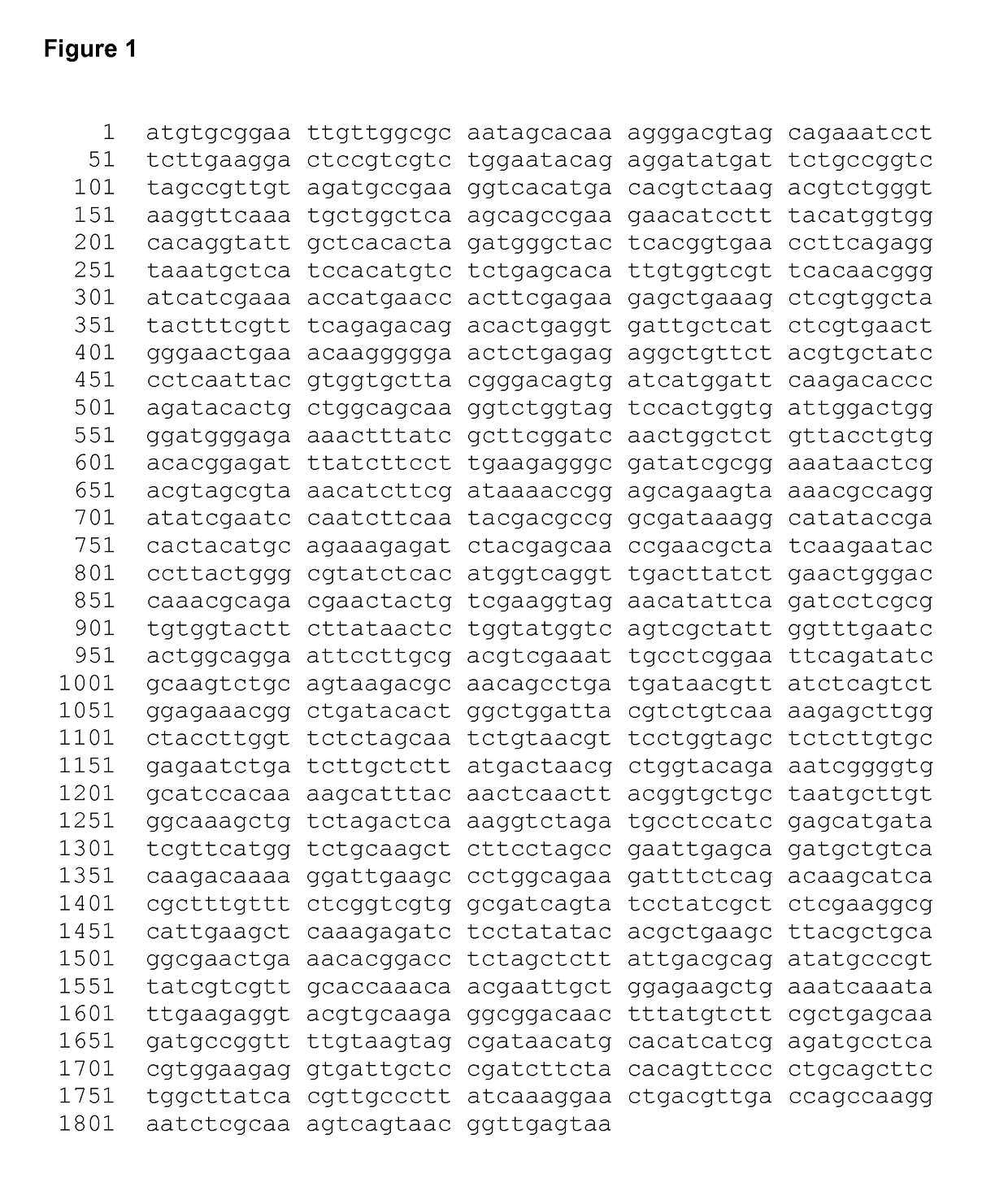Cotton fibers with increased glucosamine content
a technology of glucosamine and cotton fibers, which is applied in the direction of enzymology, yarn, transferases, etc., can solve the problems of not possessing the chemical versatility of cotton fibers and not enduring well washing
- Summary
- Abstract
- Description
- Claims
- Application Information
AI Technical Summary
Benefits of technology
Problems solved by technology
Method used
Image
Examples
example 1
Construction of a Chimeric Gene Encoding a Glutamine:Fructose-6-Phosphate-Amidotransferase (GFAT) Protein for Expression in Cotton Cells
[0119]A DNA molecule having the nucleic acid sequence according to SEQ ID 1 was synthesized by Entelechon GmbH. The nucleotide sequence was designed i) to encode a polypeptide according to SEQ ID 2 and ii) to optimize the nucleotide sequence for expression in cotton plant cells. For this purpose, factors such as codon usage, mRNA secondary structure, the AT content, cryptic splice sites or restriction sites were taken into account.
[0120]The resulting nucleotide sequence as disclosed in SEQ ID 1 is 75% identical (1390 matching bases out of 1830) to the published nucleotide sequence encoding a GFAT protein from E. coli which was adapted to the codon usage in plants (WO 2007 / 039314).
[0121]Using standard recombinant DNA techniques, the following chimeric GFAT gene was constructed: A chimeric glutamine-6-phosphate-amidotransferase gene comprising the fol...
example 2
Generation of Transgenic Cotton Plants Expressing a Glutamine: Fructose-6-Phosphate Amidotransferase
[0148]The T-DNA vectors were introduced into Agrobacterium tumefaciens strains containing a helper Ti-plasmid and used in cotton transformation essentially as described in WO00 / 71733. T0 plants were further analyzed as described in Example 3.
example 3
Determination of the Glucosamine Content of Cotton Fibers
[0149]Fibers from transgenic cotton T0 plants were isolated, treated with trifluoroacetic acid (TFA) to hydrolyze the glucosamine polymers and analyzed for the glucosamine content by HPLC. All steps were carried out following standard protocols.
[0150]Fibers of untransformed lines contained about 0.01% of GlcN. The results for the measured glucosamine content of cotton fibers from different T0 plants expressing the GFAT gene according to the invention under the control of the SCW-PRP promotor (transformed with pTDBI 252) are depicted in Table 3.
TABLE 3GlcN content of cotton fibers from individual T0 plantsGFAT optimized (pTDBI 252)GFAT control (pTGK 110)pl1 0.0115 *cpl1 0.0101 *pl2 0.0118 *cpl2 0.0112 *pl3 0.0136 *cpl3 0.0120 *pl4 0.0141 *cpl4 0.0121 *pl50.0318cpl5 0.0125 *pl60.0340cpl60.0316pl70.0371cpl70.0330pl80.0389cpl80.0334pl90.0401cpl90.0349pl100.0405cpl100.0425pl110.0431cpl110.0446pl120.0448cpl120.0536pl130.0472cpl130.0...
PUM
| Property | Measurement | Unit |
|---|---|---|
| Content | aaaaa | aaaaa |
| Reactivity | aaaaa | aaaaa |
| Selectivity | aaaaa | aaaaa |
Abstract
Description
Claims
Application Information
 Login to View More
Login to View More - R&D
- Intellectual Property
- Life Sciences
- Materials
- Tech Scout
- Unparalleled Data Quality
- Higher Quality Content
- 60% Fewer Hallucinations
Browse by: Latest US Patents, China's latest patents, Technical Efficacy Thesaurus, Application Domain, Technology Topic, Popular Technical Reports.
© 2025 PatSnap. All rights reserved.Legal|Privacy policy|Modern Slavery Act Transparency Statement|Sitemap|About US| Contact US: help@patsnap.com


